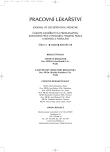Diabetes Mellitus and Professions: a Retrospective Study on Prevalence of the Disease, BMI, Glycaemia and Total Cholesterol in Serum in Selected Groups of Workers at Risk
Authors:
J. Buchancová 1; R. Mikulková 1; G. Klimentová 1; J. Javorková 2; J. Buchanec 2
Authors‘ workplace:
Klinika pracovného lekárstva a toxikológie, JLF UK a MFN Martin, vedúca prof. MUDr. Jana Buchancová, CSc.
1; Klinika detí a dorastu, JLF UK a MFN Martin, vedúci prof. MUDr. Peter Bánovčin, CSc.
2
Published in:
Pracov. Lék., 58, 2006, No. 1, s. 16-23.
Category:
Original Papers
Overview
Two groups of patients were enrolled into the study. 69 adolescents and younger adults with diabetes mellitus of the type I with the need of treatment in an intensive regimen were included in the group A. Their educational and professional level was standard or above standard. The rate of unemployment was only 2.07 % in this group which is below average in comparison with the same population in a productive age. The more serious occupational risk factors were found in 3 cases and required and individual approach in solving them.
800 workers at risk divided into subgroups of 200 members (I. chemists, II. miners, III. metallurgist, IV. sawyers) were included into the group B. The prevalence of diabetes mellitus (DM Type II) was 21.5 % in 200 miners with an average age 61.41 ± 12.7 years (x– ± SD). The prevalence of DM was 9–12 % in other younger samples of chemists, metallurgists and sawyers with an average age between 48 and 52 years. The lowest prevalence of DM II was in sawyers. Very significant differences in prevalence of DM II were proved in relation to age in subgroups below 55 and above 55 years (the increase of DM was 3–6 fold higher with age) except the group of sawyers. The subgroups with DM II were older in all groups of occupations at risk. The average values of BMI proved overweight in all groups of workers at risk, however the values of BMI were even higher in diabetics. The average BMI proved obesity in the groups of metallurgists and miners. The higher levels of total serum cholesterol were found in all groups, especially in metallurgists with DM (in the category above 55 years).
Besides well-known pathogenetic factors related to DM, the authors reminded the positive influence of physical work. On the contrary, reduction of physical activity related to the loss of work in miners and metallurgists might have a negative consequences. Health education should be implemented in prevention of DM and obesity in a more systematic way and influence the nonprofessional physical activity and eating habits in relation to repositioning, loss of work or disability. The paper reminds the possible influence of positive and negative factors at work in relation to the development of DM. Last but not least, professional stress might play its role in some cases, especially in miners, in manifestation of DM. It might be useful to carry on other prospective studies in selected samples in this field in future.
Key words:
occupational inclusion in DM I, „pure“ exposures (chemists, miners, metallurgists, sawyers), sample of 800 long-term
workers at risk, prevalence of DM II, age factor
Labels
Hygiene and epidemiology Hyperbaric medicine Occupational medicineArticle was published in
Occupational Medicine

2006 Issue 1
Most read in this issue
- Thoracic Outlet Syndrome: Treatment and Long-term Experience from the Surgical Department
- Reclassification of a Risk of an Occupational Disease in Miners of the Ostrava-Karviná Region (OKR): Evaluation after 15 Years, Assessment of Initial Powder Findings
- Acute Intoxication with Ethylalcohol
- Chronic Obstructive Pulmonary Disease in Workers Exposed to SiO₂
